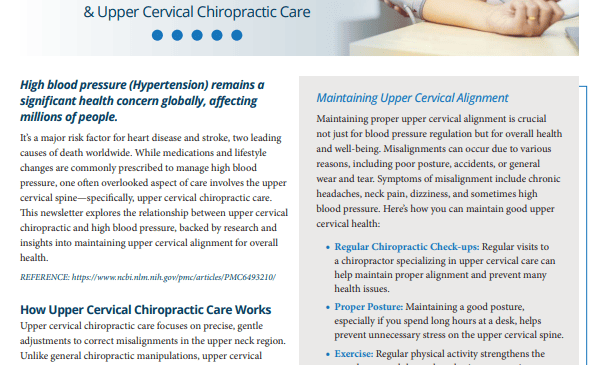High blood pressure (Hypertension) remains a significant health concern globally, affecting millions of people.
It’s a major risk factor for heart disease and stroke, two leading causes of death worldwide. While medications and lifestyle changes are commonly prescribed to manage high blood
pressure, one often overlooked aspect of care involves the upper cervical spine—specifically, upper cervical chiropractic care. This newsletter explores the relationship between upper cervical chiropractic and high blood pressure, backed by research and insights into maintaining upper cervical alignment for overall health.
REFERENCE: https://www.ncbi.nlm.nih.gov/pmc/articles/PMC6493210/
How Upper Cervical Chiropractic Care Works Upper cervical chiropractic care focuses on precise, gentle adjustments to correct misalignments in the upper neck region. Unlike general chiropractic manipulations, upper cervical corrections are low-force and specifically target misalignments (subluxations) that could affect the brainstem and neural pathways.
The theory behind the impact on blood pressure lies in the neurological connections in the upper cervical spine. The brainstem, housed within the upper cervical region, plays a vital role in autonomic functions of the body, including heart rate and blood pressure regulation. Misalignment in this area could interfere with the normal nerve function, leading to irregularities in blood pressure.
While high blood pressure is traditionally managed with medication and lifestyle changes, upper cervical chiropractic care offers a supplementary approach that could have a profound impact on blood pressure control.
This approach is grounded in the anatomical and physiological significance of the cervical spine in overall health and systemic function, particularly concerning cardiovascular health.
For those interested in exploring this option, it is crucial to consult with a professional specializing in upper cervical chiropractic care. Such a specialist can provide a thorough examination and determine whether this form of care could be beneficial. As with any medical treatment, individual results can vary, and comprehensive care involving lifestyle, diet, and medical management should be maintained.
Maintaining upper cervical alignment not only supports the structural integrity of the spine but also ensures optimal functioning of various body systems, including the cardiovascular system.


